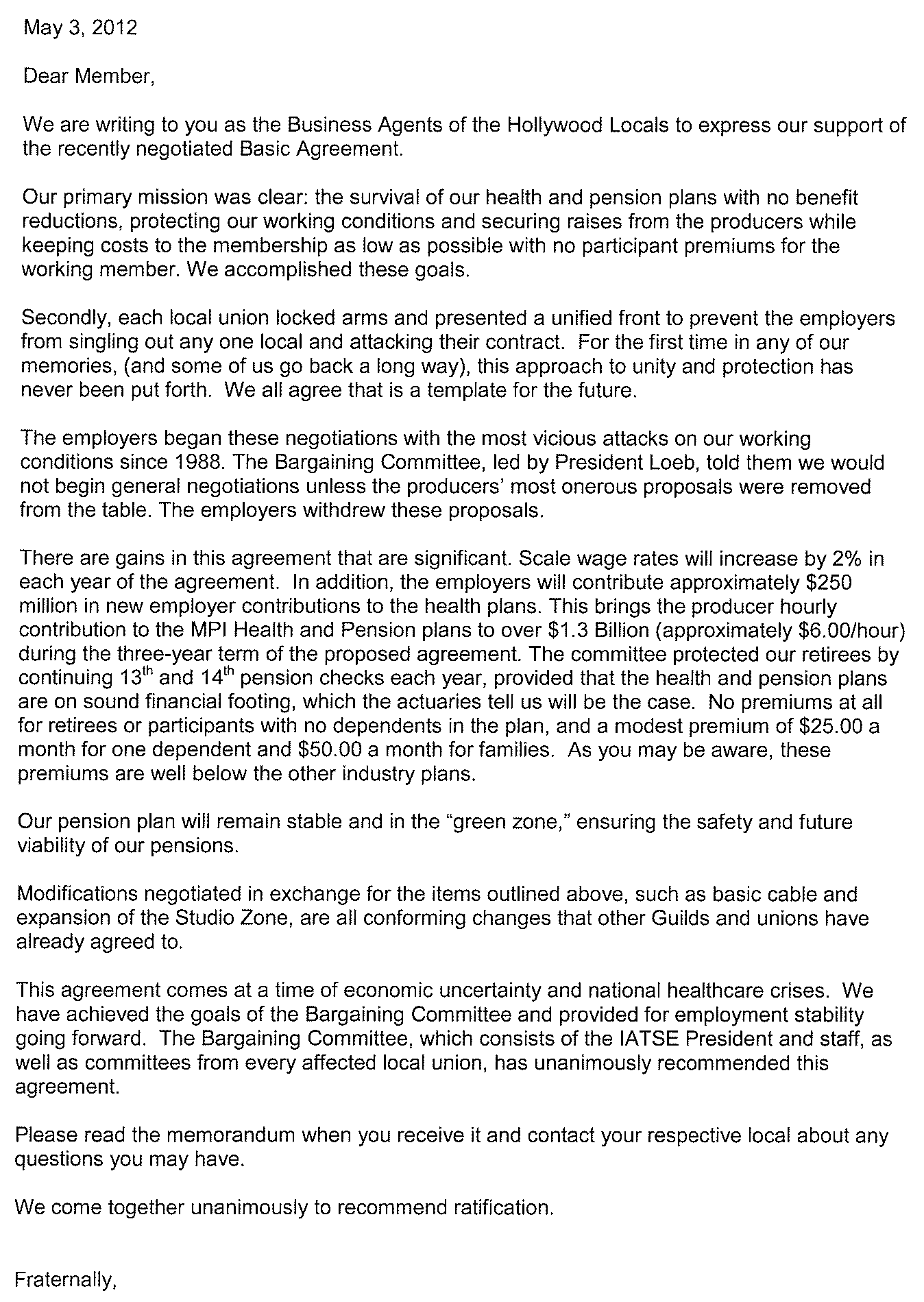Updated Wed 5/9: Facts about the New I.A. Contract
Why did the IATSE negotiate early?
- There are several reasons for this strategy. First and foremost is the fact that early negotiations promote industry stability and prevent work slowdowns and stoppages.
- These negotiations didn’t begin until March and concluded on April 12th. This is the latest start and latest conclusion to negotiations in recent history.
- There is value to the producers in being able to plan and budget past July and we use that value to our benefit.
Why did the negotiations break off in March?
- The negotiations broke off in March due to a dispute related to premiums in the health plan and how they would affect the membership, including whether single participant members or members with no one else in the plan would be required to pay premiums.
Who negotiated this contract on behalf of the Union?
- The bargaining committee was led by International President Matt Loeb and consisted of International officers and representatives, Local Union officers and committee members from each of the West Coast Studio Local Unions. This committee was supported by staff and hired professionals including actuaries, lawyers, health care consultants, and pension consultants.
What did we achieve in this contract?
- We were able to prevent the employers from changing any of the conditions of the Local Union agreements. This means no changes to staffing, no reductions to overtime or meal penalties or any other working conditions in the Local contracts.
- A three year contract (through July of 2015) that will provide for employment stability as this challenging economy continues.
- Wage increases of 2% in each year, compounded.
- Retirees will continue to receive their 13th and 14th checks for the duration of this agreement. This will continue provided there are 8 months of reserves in the Health Plans and the Pension continues to be in the “Green Zone”. These checks are provided to those that retired prior to August of 2009, many of whom did not benefit from the pension increases that have been negotiated since 1996.
- The employers will increase their contributions to the health plan by approximately $250 million dollars. (This is over and above the wage increases.)
- A pension funding plan that continues to insure the safety of your pensions and maintains safe “Green Zone” status.
How does the proposed agreement compare to inflation?
- According to the Bureau of Labor Statistics (www.bls.gov) the Consumer Price Index (CPI) in Southern California for the first quarter of 2012 is 2%. Our negotiated wage increase alone is 2%. However, it is important to recognize that in addition to the wage increase the employers will be contributing an additional $1.00 per hour into the MPIPHP. For a member making $33 per hour that equals an additional 3% on top of our wage increase.
What about the Health plan?
- An increase of $1.00 per hour beginning on August first of this year. This will result in NEW and additional employer payments to the plan of approximately $225 million.
- This contract contains a reallocation of $.305 (30 ½ cents) per hour from the Individual Account Plan into the Active Health Plan. This reallocation helps to insure the Pension checks for the retirees and the stability of the health plan by keeping the plan adequately funded.
- Members will recall that in the past, money was reallocated from the Health Plan into the IAP. This reallocation is on a going forward basis after August 1, 2012.
- There will be an additional employer contribution of $1.50 per hour for Non-Affiliate participants in the health plan worth almost $20 million.
- There will be no employee premium payments for the primary participant.
- There will be no premium payments for retirees or the dependents of retirees.
- For active participants that have 1 additional person in the MPIPHP there is a $25 per month premium. For two or more dependents in the MPIPHP the premium is $50. These payments will be made quarterly and electronic payment will be accepted.
When does the IAP reallocate to the Health Plan?
- The reallocation will begin August 1.
Will money be taken from my IAP and put in the Health Plan?
- No. The money that is in the IAP is yours and will not be used to pay for the health plan. The IAP contribution of 6% will remain unchanged. Only the 30 ½ cents per hour currently being paid by the employer is being shifted to the health plan.
When will I have to start paying the premium if I have dependents?
- The premium payment will not start until January of 2013.
Why did we bargain for premiums instead of a wage freeze?
- A wage increase is a better deal for the overwhelming majority of the IA members in the plan. The wage increase begins at the end of July and compounds each year. The premium payments begin in January of 2013.
- If you have no dependents in the Health plan, you pay nothing and will see the full benefit of the 2%wage increase immediately.
- If you have 1 additional dependent in the plan you will have a premium of $300 for the whole year. Therefore the wage increase negotiated into the agreement will have paid for the premium once you have earned $15,000 per year.
- If you happen to have a family with 2 or more dependents in the plan your premium will be $600 for the entire year. The 2% wage increase will pay for that premium once you have earned $30,000.
What does it cost the Health Plan to cover me and my family??
- The cost to the MPI is $5,800 per year for singles, $12,000 per year for 2 people and $19,000 for families.
How do these premiums compare with the other Industry Unions and Guilds?
- SAG premiums are $273-$477 per quarter for single, $315-$477for Plus 1 and $342-$519 for a family.
- AFTRA’s premium is $381 per quarter for single, $668-$2612 for Plus 1 and $668-$4249 for a family.
- The DGA quarterly premium is $195 for Plus 1 and $300 for a family.
- The WGA quarterly premium is $150 for Plus 1 and $150 for a family.
How will the premium payments be collected?
- The premiums will be due quarterly, starting in January of 2013. Automatic and electronic payments will be accepted.
Are there any increases to the Prescription Drug co-pays?
- No. The prescription drug co-pays will remain as they are.
What do the employers pay into our Health and Pension Plans?
- First, they pay an hourly contribution of approximately $5.00 per hour. The $1.00 increase represents a 20% increase in that hourly amount.
- In the term of this agreement is it estimated that the employers will pay approximately $900 MILLION into the Health Plan through hourly contributions, not counting the residual obligation.
- They also pay residuals. Residuals fluctuate each year and are dependent upon DVD sales, download to own, pay TV, etc. The residual estimate for this agreement is $322 Million per year or almost $1 Billion over the term of the new agreement.
- The employer also will continue to pay 6% of wages into the Individual Account Plan.
Did the eligibility hours go up?
- No. There will be no increase in the qualifying hours.
- The employers proposed to increase the pension hours from 400 to 1000 to earn a qualified year under the pension and retiree health plan but that proposal was rejected by the Union.
Will my benefits be cut?
- No. There are no benefit reductions in this contract.
How were Basic Cable and Home Video Production dealt with?
- Home Video projects may use the Movie of the Week (MOW) or Low Budget Agreements.
- Basic Cable TV Productions shot in Los Angeles will continue to be treated the same way as they have since 2003. The first year will be Movie of the Week rates the second year rates will lag one year and in the third year the rates will lag one year. In the fourth year of a basic cable series the full Basic Agreement will apply.
Why were Basic Cable and Home video negotiated now?
- These areas were specifically addressed because they are either not being produced in LA (Home Video) or they are at risk of leaving Los Angeles. This was designed to keep Basic Cable Television in LA.
Do other Unions have this Basic Cable deal?
- Yes. The Teamsters, Electricians, Plumbers, Plasterers and Laborers all negotiated this into their agreements.
What concessions were granted to Network TV and Feature Films?
- None. The Employers proposed massive rollbacks in TV that would have resulted in wage cuts of 20% or more. These proposals were rejected by the union.
How was the Studio Zone expanded?
- The Studio Zone was expanded to be consistent with the other Industry Unions and Guilds that already consider these locations within the Studio Zone. They are Agua Dulce, Castaic (including Lake Castaic), Leo Carillo State Beach, Ontario Airport, Piru and Pomona.
How does this deal compare with other Industry Guild agreements reached since our last negotiation?
- Many will recall that the Industry pattern set after the IA negotiated last time was 2% wage increase and 1.5% increase in the benefits contribution. This agreement is richer than that pattern. Our increase of 2% and $1.00 per hour into the benefit plans is worth roughly 5% in the first year. The overall value of this contract for a member with a $33.00 wage rate is over 9%, front loaded, which means that all of the benefit increase go into the plan starting in the first year, rather than being spread out over three years as has been done in the past.
When do we get to vote on the proposed contract?
- The memorandum of agreement is being reviewed and finalized right now. It will be sent to the membership for ratification as soon as it is finalized.
Will I get a copy of the proposed changes before I vote?
- Yes, each member will receive a memorandum of agreement that will contain all of the details of the new contract, along with a ballot and voting instructions.
Do I even need to vote?
- The answer is YES!
- The vote is determined by the number of ballots that are returned. So if you don’t vote you’re not counted.
- Historically, the membership returns less than a third of the ballots that are sent out. That means that 2/3 of the membership are turning over the decision making regarding this contract to less than 1/3 of the members.
Is a no vote a strike vote?
- Yes. If you elect to vote no, you will be electing to authorize a strike.
Why is a “No” vote electing to authorize a strike?
- This tentative agreement represents the best offer from the employers. In order to demand more and not have the employers view a return to the table as an opportunity to take back, your bargaining committee must have the authority to call for a strike in the likely event that the employers are unwilling to increase their current offer.
What is the recommendation of the Committee?
- The bargaining committee unanimously voted to recommend this contract for ratification by the members.





